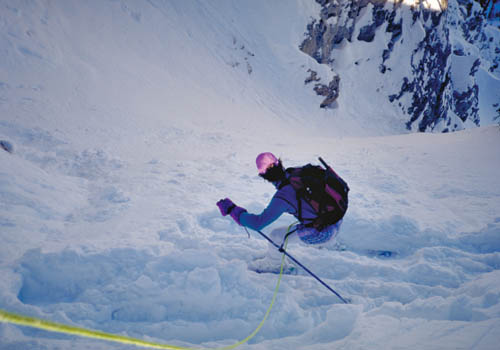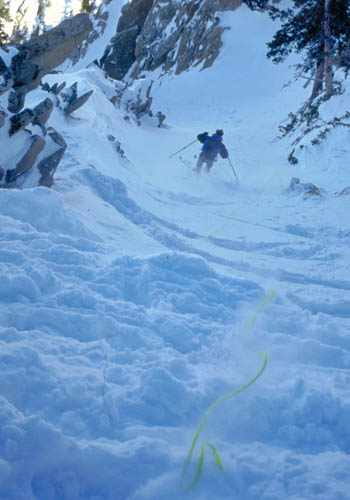Belayed Ski Cuts
At times when you want to do a ski cut, but there is no island of safety to ski to, a belayed ski cut comes in handy. Prime candidates for belayed ski cuts are narrow, steep couloirs with no hiding spots, or the opposite end of the spectrum, wide open faces.
For this type of ropework, simplicity and expediency is desirable as if you get too complex and time consuming, you might decide that it’s not worth going to the effort of pulling out the rope, and thus skip it. For this reason, I keep ski cutting belays as basic as possible – skip the harness and tie the rope directly around the cuttee’s waist, and then use a hip belay from above. Total ingredients – one rope and about 60 seconds.
The idea with a belay is to help pull the skier off the slab when and if it breaks. Hopefully it will break either right at his feet, or just above him, so the pressures of arresting the skier will not be that great (compared to arresting a belayed rock climbing fall).
For almost any type of belayed skiing, a hip belay works well as it allows the belayer to pay out rope quickly and smoothly. My technique of choice is to not have the belayer tie-in, but instead to leave the end of the rope free, so that when the person is done with the ski cut and the rope is all paid out, the belayer lets go of the rope and the skier goes down with it trailing. This serves two purposes; first, it acts as an old school avalanche cord which may help if the skier is caught and buried in a slide, and second, once the first person gets to a safe spot, he can coil the rope while the next person skis down, so there is no wasted time.
For a general purpose belay/mini rappel/day ski touring rope, I use a 50-100′ length of 8mm accessory cord. It is not the strongest rope in the world, but it is compact, cheap and readily available. Bigger, beefier ropes are better, but if the bulk keeps you from carrying them, then what is the point?
________________________________
Help support StraightChuter.com and don’t forget your Mountain Hardwear Vertical Pants from Backcountry.com. Click on the photo below…
Category: 07 Avalanche Avoidance












is mark one of those aliens from the latest indiana jones movie? i think i can see his brain.
check out the big brain on mark.
Wow, thanks for touching on this Andrew…impressive turn around time too.
Cheers!
Andrew,
Any thoughts on how to be sure the slope triggers if it’s going to before you cut the rope?
I definitely liked this tip.
You mentioned you use “8mm accessory cord” though. In my mind, “accessory cord” = static. You don’t use something like the dynamic 30m Beal Rando?
You never really know if a slope is going to fracture or not. If it is rock hard snow, I probably wouldn’t even bother with a belayed ski cut. On the other hand, if it is like in the photos above and you suspect that it might slide, it is almost worse when it doesn’t. If it slides, then it is like a bomb going off – it clears everything out. If it doesn’t slide…? Ski with caution. One advantage of a belayed ski cut is you can spend a lot of time stomping and pounding on the slope to really try to get it to go. The harder you do this, the more confidence you might have in the snow.
Colin – I buy my accessory cord by the spool and it is just plain old “accessory cord” – not static, nor dynamic. It is way more elastic than dynamic cord, which isn’t great, but then again, I’m not taking leader falls on it or using it for glacier travel either.
I have some static cord, but never use it in a case where it could get suddenly loaded. Instead, I might anchor it and use it to pull up a pack, or assist someone who is doing a self rescue.
For the love of discussion, I’ll elaborate! I’ve debated this topic with companions and have come up with a variety of options all with pros and cons. The execution of such is defiantly not written in stone and requires conforming to the variables of the situation and the equipment on hand. My solution is; Cutting in a pendulum fashion on a taught line with the cuttee in control of the belay (as if the don’t have enough to do already) with 3 meters of tail (to get tangled under there skis.) There in control of the belay so they can give a little slack if need be, grit there teeth and hang on for dear life, or the last option to release entirely. It’s never happened to me, but I’ve played out a scenario in my mind where a ridge line wind slab breaks away during the cut, then the cuttee would pivot there tips up hill while the magic carpet pulls away under there feet.
I appreciate your dedication towards group mobility and efficiency in the mountains. As I hadn’t considered the benefits of continuing down hill, while still tied in?
Hi Dan – Yes, that would be a good way to go as well. For that matter, you could fix the rope to an anchor (tree, rock, ski anchor) and totally cut the other person out of the picture so they could maneuver and keep an eye on you.
There is also the idea that the cutter should tie into the back of his harness so the rope trails more naturally.
Hi Scott! Yes, that is the way I’ve done it, but that requires a full-strength rear tie-in loop. I’ve also done it where you tie in to the front, then wrap the rope snuggly around your waist and clip it to the back of the harness with a biner.